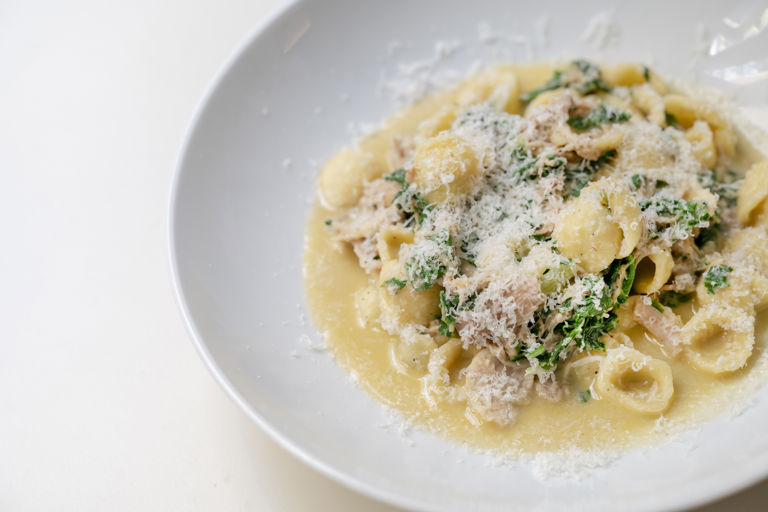Orecchiette with braised rabbit and Swiss chard

Making fresh orecchiette – a Puglian pasta shape meaning 'little ears' – is simple to do at home as it doesn't require any specialist equipment. Here, it's tossed in a light, elegant and buttery sauce of braised rabbit and Swiss chard, resulting in a wonderful dish that shows off plenty of Italian technique.
Ingredients
Metric
Imperial
Orecchiette
- 170g of water
- 225g of 00 flour
- 170g of semolina, plus extra for dusting
Rabbit
- 2 rabbit legs
- 2 rabbit shoulders
- 1 carrot, peeled and roughly chopped
- 1 large shallot, roughly chopped
- 1 celery stick, roughly chopped
- 5 garlic cloves, unpeeled
- 2 fresh bay leaves
- 4 sprigs of thyme
- 125ml of white wine
- 700ml of chicken stock
- 400g of Swiss chard
- 50g of unsalted butter
- sea salt
- freshly ground black pepper
- olive oil, for frying
- 1 lemon, zested
- Parmesan, freshly grated, to serve
Method
Begin by making the orecchiette. Place the water, semolina and flour into a mixing bowl and bring together into a dough. Tip out on to a work surface and knead for around 10 minutes, until the dough is smooth, then wrap in cling film and refrigerate for 1 hour
- 170g of water
- 225g of 00 flour
- 170g of semolina, plus extra for dusting
After 1 hour, roll out the dough until around 1cm thick, then cut into 1cm cubes. Scatter some semolina onto a tray or plate and set aside. Take a cube and, using your thumb or a butter knife, scrape the dough against the work surface with a good amount of pressure so it curls up, then turn it inside out over your finger to create a shape that resembles a little ear. Place the orecchiette on the tray dusted with semolina, convex-side up. Repeat with the remaining cubes, then leave them uncovered at room temperature to dry out for around an hour
Meanwhile, prepare the rabbit. Preheat an oven to 170°C/gas mark 3½ and place a wide frying pan over a medium heat. Season the rabbit legs and shoulders well with salt, then add a drizzle of olive oil to the pan and sear them all over for around 2-3 minutes each side until lightly browned all over. Transfer the rabbit to a deep baking tray or casserole dish
- 2 rabbit legs
- 2 rabbit shoulders
- sea salt
- olive oil, for frying
Add the roughly chopped vegetables, garlic cloves, bay leaves and thyme to the same pan with a little more oil and gently fry over a medium heat for 5-10 minutes, until they just begin to brown. Pour in the wine, simmer for a few minutes to cook off the alcohol, then pour in the chicken stock and bring to the boil
- 1 carrot, peeled and roughly chopped
- 1 large shallot, roughly chopped
- 1 celery stick, roughly chopped
- 5 garlic cloves, unpeeled
- 2 fresh bay leaves
- 4 sprigs of thyme
- 125ml of white wine
- 700ml of chicken stock
Once boiling, pour the contents of the pan into the tray or dish of rabbit. Place a sheet of baking paper on top, then wrap very tightly in foil. Transfer to the oven and cook for 1 hour
Meanwhile, bring a large pan of salted water to the boil. Strip the chard leaves from their stalks, then blanch the leaves for 1 minute. Drain and immediately transfer the leaves to iced water to refresh, then drain again, squeeze the leaves to drain any excess water and roughly chop. Set aside
- 400g of Swiss chard
After 1 hour, remove the tray from the oven and transfer the rabbit to a plate and leave to cool slightly. Once cool enough to handle, roughly shred the meat from the bones and set aside. Strain the braising liquid into a clean pan, discarding the vegetables
Bring a large pan of salted water to the boil for the pasta. While you wait, add a few ladlefuls of the strained stock into a sauté pan with the shredded rabbit meat. Gently heat through over a low-medium heat and add the butter, lemon zest and plenty of black pepper
- 50g of unsalted butter
- freshly ground black pepper
- 1 lemon, zested
Cook the pasta in the boiling water for 3-5 minutes, until al dente. Lift them out with a slotted spoon and add the orecchiette directly to the rabbit sauce with the chard, tossing vigorously to combine. The sauce should thicken and coat the pasta evenly – if it becomes too thick, you can add a little more stock
- Parmesan, freshly grated, to serve
Get in touch
Please sign in or register to send a comment to Great British Chefs.


